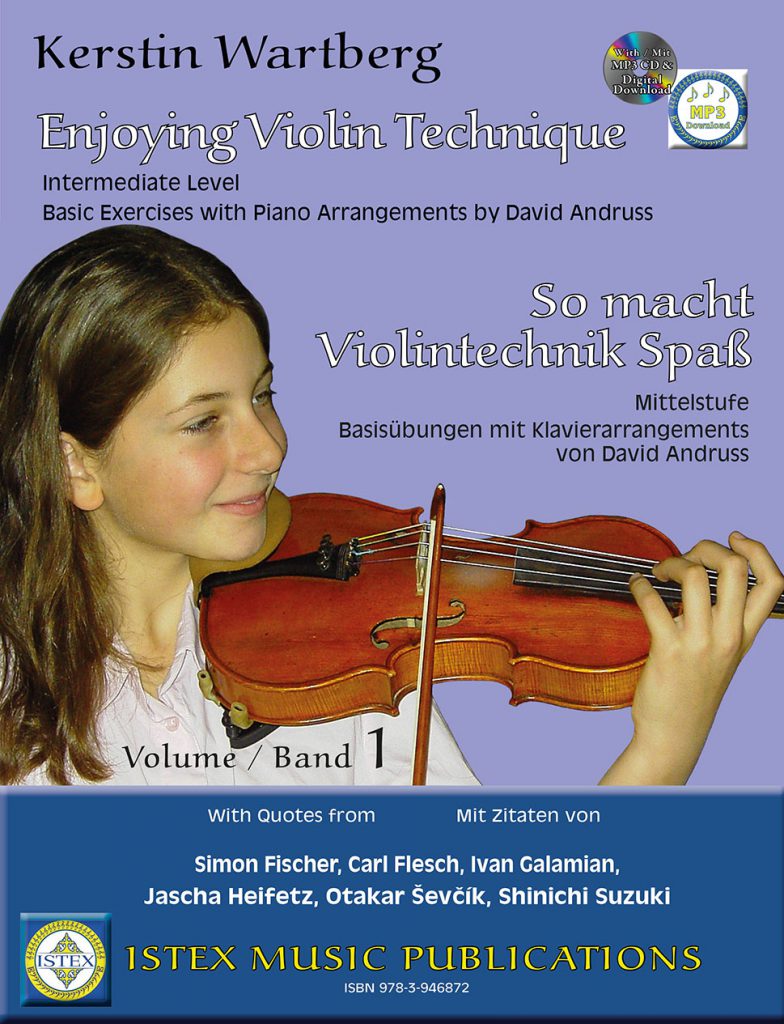In the November issue of 2019, the world’s most renowned string magazine THE STRAD wrote a very positive review of the book “Enjoying Violin Technique” by Kerstin Wartberg, which we would like to present you here.
Kerstin Wartberg
Enjoying Violin Technique
Intermediate Level:
Basic Exercises with Piano Arrangements by David Andruss
74PP ISBN 9783946872009
ISTEX MUSIC PUBLICATIONS €19.80
Violin teachers all know we should be using studies with our more advanced pupils, but it’s often difficult to know where to start. Students who have grown up on accessible series such as those by Mary Cohen and Herbert Kinsey will not necessarily take kindly to being presented with the complete works of Ševčík and other hardcore pedagogues, and even Simon Fischer’s highly respected tomes are rather daunting for younger players. Kerstin Wartberg’s Enjoying Violin Technique is a volume that might just bridge the gap. It is aimed at “young violin students of the intermediate level“, and contains a range of technical exercises, some original and some adapted from violinists past and present – Flesch, Heifetz, Galamian, DeLay and Perlman are all referenced, and Fischer‘s influence is evident throughout. There are ten chapters, each focusing on a different point of technique, and every exercise has a downloadable mp3 accompaniment. The idea behind this, the author says, is that “playing with the piano […] is highly motivating and encourages [students] to practise in a more focused way”. Right from the first exercise in the book (one-octave scales in first to sixth positions) it is clear that the student is embarking upon a proper, no-nonsense sort of project. Shifting is covered through a useful adaptation of Ševčík op.8, and Flesch-style scales and arpeggios on one string calmly take the student up to eighth position. Three-octave scales and arpeggios up to C are also tackled. The section on vibrato is wordy but worth it, and the two original studies in this chapter complement the exercises perfectly. Kreutzer puts in an appearance near the end of the book in an adapted version of no.15, and there is an intense chapter on double-stops, which is not for the faint-hearted. In all of this, the piano accompaniments are just right – they are enjoyable to play along with, and they support and encourage the player without distracting from the task in hand. The book is full of solid explanation, and the practice tips are helpful. Not everything in the book will chime with every teacher, and some may choose to skip over or adapt sections such as those on block fingering and thumbled downward shifting.
A few small gripes: the low-resolution cover photo spoils the initial impression, and the many different typefaces make the pages feel busy. The CD of mp3 files seems pointless, since a link to the audio files is provided within the book. An audio CD might have been useful, although CD players are fast becoming obsolete and it might be worth the author considering a Spotify playlist or something equally new-fangled next time. The text errs on the wordy side, and the effect of the translation into English from the original German text is sometimes a little quaint, but the overall impression is sincere and not a little heart-warming: “Dear violin teacher, I want to assure you that your students will improve significantly through regular practice with this material and that you will be very pleased with the results.”
If you were to take a selection of a dozen or so violin teachers’ favourite technical exercises and put them all together, the end product would probably be fairly similar to this book. It will suit serious-minded young students from Grade 6 upwards who feel ready for the challenge of exploring their violin in a systematic way. I will certainly be using it in my teaching, and I very much look forward to the second (as yet unpublished) volume.
CELIA COBB


